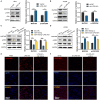LncRNA LIPE-AS1 Predicts Poor Survival of Cervical Cancer and Promotes Its Proliferation and Migration via Modulating miR-195-5p/MAPK Pathway
- PMID: 33898314
- PMCID: PMC8062982
- DOI: 10.3389/fonc.2021.639980
LncRNA LIPE-AS1 Predicts Poor Survival of Cervical Cancer and Promotes Its Proliferation and Migration via Modulating miR-195-5p/MAPK Pathway
Retraction in
-
Retraction: LncRNA LIPE-AS1 Predicts Poor Survival of Cervical Cancer and Promotes Its Proliferation and Migration via Modulating miR-195-5p/MAPK Pathway.Front Oncol. 2022 Feb 8;12:858846. doi: 10.3389/fonc.2022.858846. eCollection 2022. Front Oncol. 2022. PMID: 35211419 Free PMC article.
Abstract
Aims: A growing number of studies have unveiled that long non-coding RNA (lncRNA) is conductive to cervical cancer (CC) development. However, the effect of LIPE-AS1 is remained to be studied in CC. Main Methods: Reverse transcription-polymerase chain reaction (RT-PCR) was employed to measure LIPE-AS1 expression in CC tissues and the adjacent normal tissues. Additionally, we conducted gain- and loss-of functional experiments of LIPE-AS1 and adopted CCK8 assay, BrdU assay, and in vivo tumor formation experiment to test the proliferation of CC cells (HCC94 and HeLa). Besides, the apoptosis, invasion, and epithelial-mesenchymal transformation (EMT) of CC cells were estimated using flow cytometry, transwell assay, and western blot, respectively. Further, LIPE-AS1 downstream targets were analyzed through bioinformatics, and the binding relationships between LIPE-AS1 and miR-195-5p were verified via dual-luciferase activity experiment and RNA Protein Immunoprecipitation (RIP) assay. Moreover, rescue experiments were conducted to confirm the effects of LIPE-AS1 and miR-195-5p in regulating CC development and the expressions of MAPK signaling pathway related proteins were detected by RT-PCR, western blot, and immunofluorescence. Key Findings: LIPE-AS1 was over-expressed in CC tissues (compared to normal adjacent tissues) and was notably related to tumor volume, distant metastasis. Overexpressing LIPE-AS1 accelerated CC cell proliferation, migration and EMT, inhibited apoptosis; while LIPE-AS1 knockdown had the opposite effects. The mechanism studies confirmed that LIPE-AS1 sponges miR-195-5p as a competitive endogenous RNA (ceRNA), which targets the 3'-untranslated region (3'-UTR) of MAP3K8. LIPE-AS1 promoted the expression of MAP3K8 and enhanced ERK1/2 phosphorylation, which were reversed by miR-195-5p. Significance: LIPE-AS1 regulates CC progression through the miR-195-5p/MAPK signaling pathway, providing new hope for CC diagnosis and treatment.
Keywords: LIPE-AS1; MAP3K8; MAPK signaling pathway; cervical cancer; miR-195-5p.
Copyright © 2021 Zhang, Jiang, Wang, Cheng and Fu.
Conflict of interest statement
The authors declare that the research was conducted in the absence of any commercial or financial relationships that could be construed as a potential conflict of interest.
Figures








Similar articles
-
LncRNA FLVCR1-AS1 mediates miR-23a-5p/SLC7A11 axis to promote malignant behavior of cervical cancer cells.Bioengineered. 2022 Apr;13(4):10454-10466. doi: 10.1080/21655979.2022.2059958. Bioengineered. 2022. PMID: 35465835 Free PMC article.
-
LncRNA FBXL19-AS1 promotes proliferation and metastasis of cervical cancer through upregulating COL1A1 as a sponge of miR-193a-5p.J Biol Res (Thessalon). 2021 Aug 16;28(1):20. doi: 10.1186/s40709-021-00151-8. J Biol Res (Thessalon). 2021. PMID: 34399848 Free PMC article.
-
Long Noncoding RNA DLX6-AS1 Promotes the Progression in Cervical Cancer by Targeting miR-16-5p/ARPP19 Axis.Cancer Biother Radiopharm. 2020 Mar;35(2):129-136. doi: 10.1089/cbr.2019.2960. Epub 2020 Feb 20. Cancer Biother Radiopharm. 2020. PMID: 32077747
-
Long Non-Coding RNA AGAP2-AS1/miR-628-5p/PTN Axis Modulates Proliferation, Migration, Invasion, and Apoptosis of Glioma Cells.Cancer Manag Res. 2020 Jul 20;12:6059-6068. doi: 10.2147/CMAR.S250890. eCollection 2020. Cancer Manag Res. 2020. Retraction in: Cancer Manag Res. 2020 Oct 07;12:9711. doi: 10.2147/CMAR.S283113. PMID: 32801858 Free PMC article. Retracted.
-
A review on the role of MCM3AP-AS1 in the carcinogenesis and tumor progression.Cancer Cell Int. 2022 Jul 5;22(1):225. doi: 10.1186/s12935-022-02644-5. Cancer Cell Int. 2022. PMID: 35790972 Free PMC article. Review.
Cited by
-
Survival‑related DLEU1 is associated with HPV infection status and serves as a biomarker in HPV‑infected cervical cancer.Mol Med Rep. 2022 Mar;25(3):77. doi: 10.3892/mmr.2022.12593. Epub 2022 Jan 11. Mol Med Rep. 2022. PMID: 35014679 Free PMC article.
-
Long noncoding RNA SNHG3 promotes malignant phenotypes in cervical cancer cells via association with YAP1.Hum Cell. 2022 Jan;35(1):320-332. doi: 10.1007/s13577-021-00644-7. Epub 2021 Nov 24. Hum Cell. 2022. PMID: 34816392
-
Comprehensive Analysis of Ferroptosis-Related LncRNAs in Breast Cancer Patients Reveals Prognostic Value and Relationship With Tumor Immune Microenvironment.Front Surg. 2021 Oct 4;8:742360. doi: 10.3389/fsurg.2021.742360. eCollection 2021. Front Surg. 2021. PMID: 34671639 Free PMC article.
-
LncRNA FLVCR1-AS1 mediates miR-23a-5p/SLC7A11 axis to promote malignant behavior of cervical cancer cells.Bioengineered. 2022 Apr;13(4):10454-10466. doi: 10.1080/21655979.2022.2059958. Bioengineered. 2022. PMID: 35465835 Free PMC article.
-
Identification of Differentially Expressed Non-coding RNA Networks With Potential Immunoregulatory Roles During Salmonella Enteritidis Infection in Ducks.Front Vet Sci. 2021 Jun 16;8:692501. doi: 10.3389/fvets.2021.692501. eCollection 2021. Front Vet Sci. 2021. PMID: 34222406 Free PMC article.
References
Publication types
LinkOut - more resources
Full Text Sources
Other Literature Sources
Miscellaneous

